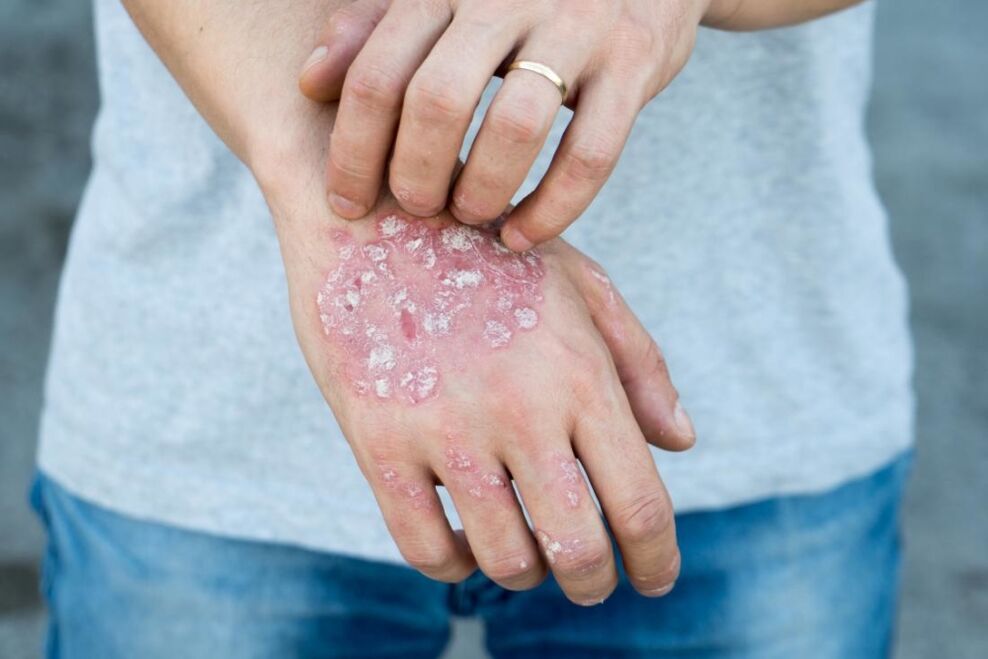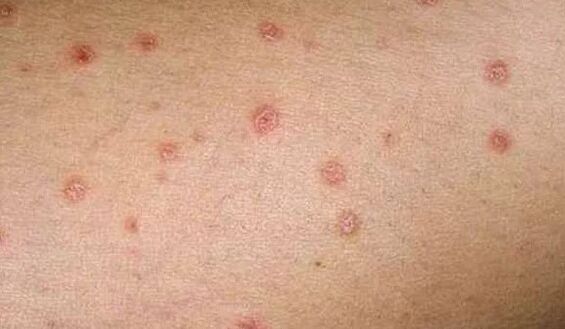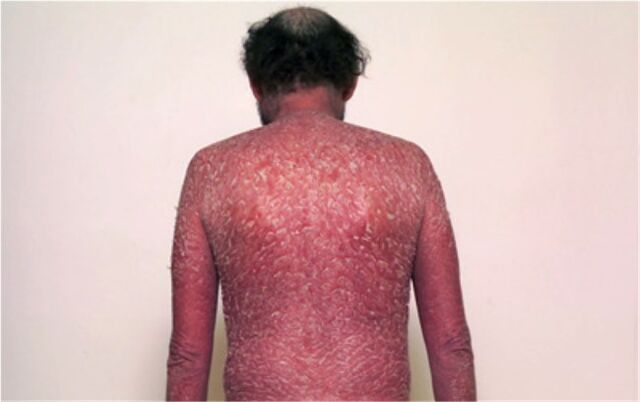Psoriasis is one of the most common chronic skin pathologies in the world, and the problem of treatment remains urgent.According to statistics, by 2017, 130 ml of cases are registered in the world: every twenty -four resident of the planet suffers from a disease.In general, the pathology debuts from 16 to 20 and 40 to 60 years.In 65% of the patients, it is observed in a mild form, and the surface of the skin is affected by the plates slightly (up to 3%).The average degree of psoriasis suffers 25% (up to 10% of the skin area) and severe, in which more than 10% of the surface is affected: 8%.

The exact cause of the disease has not yet been studied.It is assumed that a parasitic infection, an allergic predisposition, hormonal imbalance, metabolic disorders and inheritance can cause the appearance of psoriatic plaques.
The tendency to develop psoriasis in childhood, if one of the parents is sick, is 25%.When both, probability increases to 50%.According to statistics, of every 100 boys in the world, 4 of them are psoriasis and cases of ailment in boys, less frequently than girls in 25%.
The list of adverse factors also includes undergoing infectious diseases, neuropsychic lesions and the negative effect of low temperatures.
As a result of the interaction of several external and internal causes, there is a violation of the blood circulation of the Papillary Capa of the dermis, from which the reproduction of young and insufficiently mature epidermal cells occurs so fast that, they do not have time to mature finally, accumulated on the surface with silver in the form of silver in the form of plates or a shape of a fall.
The disease progresses so much that over time they merge and become great points.
Psoriasis lasts a lifetime and cases of self -food is single.Referral periods alternate with exacerbation, which is most frequently observed in autumn or winter time.But there are indefinite cases (all seasonal) and photosensitive (summer).
Stages
In the pathological process in psoriasis, several periods and the wave -shaped course take place with the alternation of exacerbation and remission cycles.For a specialist, the diagnosis of the disease is not difficult: it has special and specific symptoms and a characteristic type of skin in different stages of the development of pathology.
The initial stage
At the beginning, when the disease is just beginning to appear, the rashes (papules) of the size of no more than one pin head appear. In psoriasis, they are grouped into the skin of the limb curves and at first they do not progress and do not change.These guard plates (duty) so frequent.

Classical clinical manifestations in the initial stage form a triad of psoriasis:
- Wax point.The papules are covered with a white plate with a gray plate of plaque, loose and badly fixed.It can be easily scraped by a spatula.The exfoliated scales externally resemble the smallest chips of Starin substances to make candles.
- Terminal filmA soft, bright and juicy hyperemic surface is visible under a loose incursion.This is the last layer of cells that can come out.
- Bloody Dew is the final sign of the triad.It is formed when the terminal film is damaged and manifests externally as a condensate of small drops of blood, which do not merge with each other.
Psoriasis is a chronic disease and it is impossible to recover completely from it.The main task of treatment is to achieve persistent and prolonged remission.Inadequate exacerbation therapy, every two or three months are observed.The treatment in the initial stage of psoriasis is soft, and begins with the use of keratolytic products in the form of ointments and creams based on salicylic and lactic acid.
Drugs eliminate discomfort, suppress excessive cell formation, relieve inflammation and peeled.Psoriasis over time becomes resistant (stable) to the action of certain drugs.Therefore, the medicinal program is reviewed after a certain period of time.This approach is called rotation: a periodic change in the techniques that go in a circle.
Progressive stage
The second stage of the disease is the real peak of exacerbation.

The first signal: the peeling is alone in the central part of the papules, and a pink whisk remains along the edges.This is a symptom of growth, when individual eruptions increase and merge.The second sign of progression becomes a symptom of the skin reaction: 10-14 days after the lesion (abrasions, scratches) of the skin, a new typical plaque appears.Progressive psoriasis gives another symptom that is not observed in other stages: it is itching with a different intensity.The treatment of the progressive stage of psoriasis is carried out in a hospital and includes:
- Drug medications: antihistamines, non -steroidal anti -inflammatory drugs, immunostimulants, vitamins.
- Physiotherapy: PUVA, UFO, application with paraffin, sulphide and radon baths.
After patients, resort treatment of the sanatorium is recommended.In especially severe cases, corticosteroid and cytostatic agents are prescribed.Psoriasis affects nail plates.They become fragile, boring, rise on the bed.Typically, this condition with a disease occurs even for lower damage.
Stationary stage
After the progression, at the end of the fourth week, the healing of the papules occurs.Start from the center to the periphery, and the plates acquire a characteristic ring shape.Its color becomes less intense, there are no new formations.The stationary stage of psoriasis does not offer special discomfort.The patient is not painful, there is no itching.The therapeutic program remains the same.There can only be minor adjustments that pursue one goal: to give the opportunity to enter the final phase and not transform again into the progressive stage of psoriasis.

Scenery
After complex and intensive care, remission occurs, and the disease is included in the hidden phase.In the final stage, peeled psoriasis disappears, the plates acquire a pale tone.Little by little they solve and merge with the skin.An exception: the "frozen" parents called so remain in the elbows, knees, stomach and buttocks.The referral period is individual and can last from three months to several years.A patient with psoriasis should be controlled and in the first signs of exacerbation to see a doctor and undergo a treatment course.Despite chronic disease prone to relapses, subject to all recommendations, psoriasis allows you to live an ordinary and rich life.























